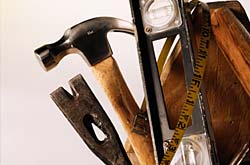Ready-Made vs. Customized Home Improvements
See if We Have Top-Rated
Home Improvement Professionals in Your Area

If you have some knowledge of the home improvement industry or an intuitive sense for the marketplace, it comes as no surprise that ready-made, manufactured goods are cheaper than customized or unfinished materials. Though the initial cost is higher for ready-made goods, the total price is universally lower due to minimizing the cost of labor. While customized projects always have some upside, choosing products can increase the difficulty from project to project. Here is a look at some of the most common home improvements that involve a choosing between ready-made and customized materials.
Pre-Finished vs. Unfinished: Floors and Doors
Hardwood flooring can be purchased in pre-finished, ready-to-install planks or unfinished planks that must be sanded, stained, buffered and coated. Along with higher costs, the process of on-site finishing may entail an extra week or two of installation time, during which the room or home will be off-limits. In terms of value and convenience, pre-finished wood flooring is the hands-down winner and, in fact, the more popular choice. Yet, unfinished wood flooring continues to find a reliable audience with wealthier homeowners who don't mind paying more for the best possible product. Plus, the only way to reliably match pre-existing wood flooring or create a consistent finish is through unfinished flooring products. In this instance, homeowners are more likely to choose a less expensive wood species to stay within budget.
Many of these ready-made vs. customized decisions are binary—either you want a contractor to customize the installation or streamline the process with ready-made products. For residential doors, however, it's more of a continuum. The various parts of a door can be ordered, assembled, partially assembled, "knocked down" or custom-built. The more assembled, the easier the installation will be. The less assembled, the higher the quality and versatility of the door can be. This decision is in addition to choosing a finished or unfinished door slab with similar pros and cons to wood flooring. If you know exactly what you want, a pre-hung, pre-finished door can allow homeowners with basic carpentry skills to install their own door.
Vinyl Siding: Behind the Cladding
Although most homeowners wouldn't think to include the project on this list, vinyl siding presents essentially the same choice during installation. As a poor insulating material, vinyl siding needs a foam underlayment for high-quality performance. This insulating layer can be included during the manufacturing process or the installation. Typically, homeowners who want the benefits of this insulation will simply upgrade their vinyl siding product with the manufacturer. However, if you want more insulation than the manufacturer can provide or know a siding contractor who is willing to install this insulation below the standard cost, manual installation of this underlayment may be the way to go.
Cabinets: Stock, Semi-Stock, and Custom-Built
Another project that has a spectrum of ready-made vs. customized choices is cabinet installation. Cabinet manufacturers have taken the principles of mass production and applied them to cabinet making. This manufacturing process has allowed homeowners to purchase and install new cabinets for a fraction of the cost. Semi-stock, also known as semi-custom, is the term given to cabinet manufacturers who allow you to change the building specifications of their stock cabinets. The modifications are limited to height, width and depth. Some cabinet manufacturers will allow dozens of modifications, but you should expect to pay more for each. Finally, custom-built cabinets are built by a craftsman to whatever specifications your home needs.
Countertops: Installation vs. Fabrication
Countertops are another piece many homeowners don't realize involves choosing between ready-made and more personalized products. With countertops, however, the dynamics and pros and cons are reversed. Many countertops can be fabricated onsite or off-site and then delivered to your home. In this case, the personal touch of onsite fabrication is usually cheaper but with reduced design options. Onsite fabrication also allows for easy measuring and installation. Off-site fabrication, on the other hand, will increase the number of edging and design options, as some of these features require heavy machinery that rules out the option of completing the fabrication at your home.
More Tips & Advice For Your Home
- Related Articles
- Recent Articles

